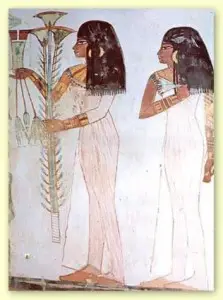Contrary to what most of the people of ancient Mediterranean wore, the Egyptians did not wear just one or two big pieces of cloth wrapped around themselves in different ways (Egyptians wear) but instead, both men and women in Egypt wore tunics which were sown so as to properly fit them. These tunics were long T-shirts which reached to the knees for men or to the ankles for women. They were usually made of linen and were almost always white. Most Egyptians including both men as well as women did not cover their heads with any kind of cloth.

The ancient Egyptians made their own clothes from what their environment and nature provided to them. Egypt mostly experienced a hot climate and hence their clothes reflected material which was lightweight so as to suit that type of climate. As a result of this, ancient Egyptians made extensive of linen. This type of fabric is light, airy, and allows freedom of movement, which is important characteristics because of the hot and sometimes humid climate of Egypt.
Fabric of Egyptians Wear
Linen is a fabric made from plant fibers. The plant fiber came from flax plants which grew in abundance along the banks of the Nile. The flax plants were plants having small leaves, blue flowers and stems about two feet tall. Flax was pulled out of the ground though it was not cut. This work was done mostly by men. Half-ripe flax stems produced the best thread.
If the stems were too ripe, then they were used for making mats and ropes. Flax stems were soaked for several days then fibers were separated. Then the fibers were beaten until soft. The resulting fibers are then spun into thread. The thread is woven into linen fabric from which the garments are made.
The ancient Egyptian both men and women wore linen clothes all throughout the hot weather. While the men wore short skirts around their waists called kilts, the women wore straight fitting dresses with straps on their shoulders. The wealthy men wore pleated kilts, and the older men wore a longer kilt. When doing any work which involved putting in a lot of efforts, men wore a loincloth, and women wore a short skirt. Children usually ran around nude during the summer months.
Contribution of Women in Textile
In Ancient Egypt, women have predominately performed the task of textile manufacturing and garment making with the help of knives and needles, both of which needed to be molded, or shaped. With these tools and linen, garments were fashioned depending upon the specific needs of the people depending upon the climate as well as their social status. Garment making was a household chore, but the woman also worked for aristocrats in spinning and weaving shops. Every garment from the decorative dresses of queens and the elaborate, pleated kilts of the pharaohs to the simpler kilts and aprons of the common people were handmade by common Egyptian women.
Contribution of Men in Textile
All men, from the tomb worker to the pharaoh, wore a kind of kilt or apron that varied in length over the years, from halfway above the knee to halfway below it. It was tied at the front, folded in at the side, or in two knots at the hips. A sleeved, shirt-like garment also became fashionable.
Apart from this, men were always clean-shaven and used razors made of bronze to shave their beards and heads. Women wore straight, ankle-length dresses that usually had straps that tied at the neck or behind the shoulders. Some dresses had short sleeves or women wore short robes tied over their shoulders. Subsequent fashions show that the linen was folded in many tiny vertical pleats and fringes were put at the edges.
Contribution of Men and Women in Textile
The wealthy Egyptian both men and women, however, wore long see-through robes which were pleated. Noblemen would sometimes wear a long robe over his kilt (Egyptians wear), while the women wore long pleated dresses with a shawl. Some kings and queens wore decorative ceremonial clothing with feathers.
A peculiar fact about the ancient Egyptian women was that they did not dress without washing. After washing, they rubbed themselves with scented oil then they placed a large rectangle of linen over their heads, gathered the loose corners up and tied them in a knot below the chest. Priests washed several times a day and could not wear leather sandals or wool clothing as it was considered unclean (Egyptians wear). They wore a leopard robe when serving the god Amun.
Most people went barefoot but wore sandals on special occasions. The king wore very elaborately decorated sandals, and sometimes decorative gloves on his hands. The sandals were sometimes made of palm fiber or braided papyrus together with leather sandals. Clothing styles were chosen for comfort in the hot, dry climate of Egypt, while in the winter, wraps and cloaks were worn. Wealthy people wore sandals made of leather that had straps across the instep and between the first and second toes.
Apart from this, the ancient Egyptians worked hard on their appearances and hence, the women spent most of their time bathing, rubbing oils and perfumes into their skin, and using their many cosmetic implements to apply make-up and style their wigs (In Egyptians wear). A woman would apply Khol, which was a black dye kept in a jar or pot which was used by men as well.
